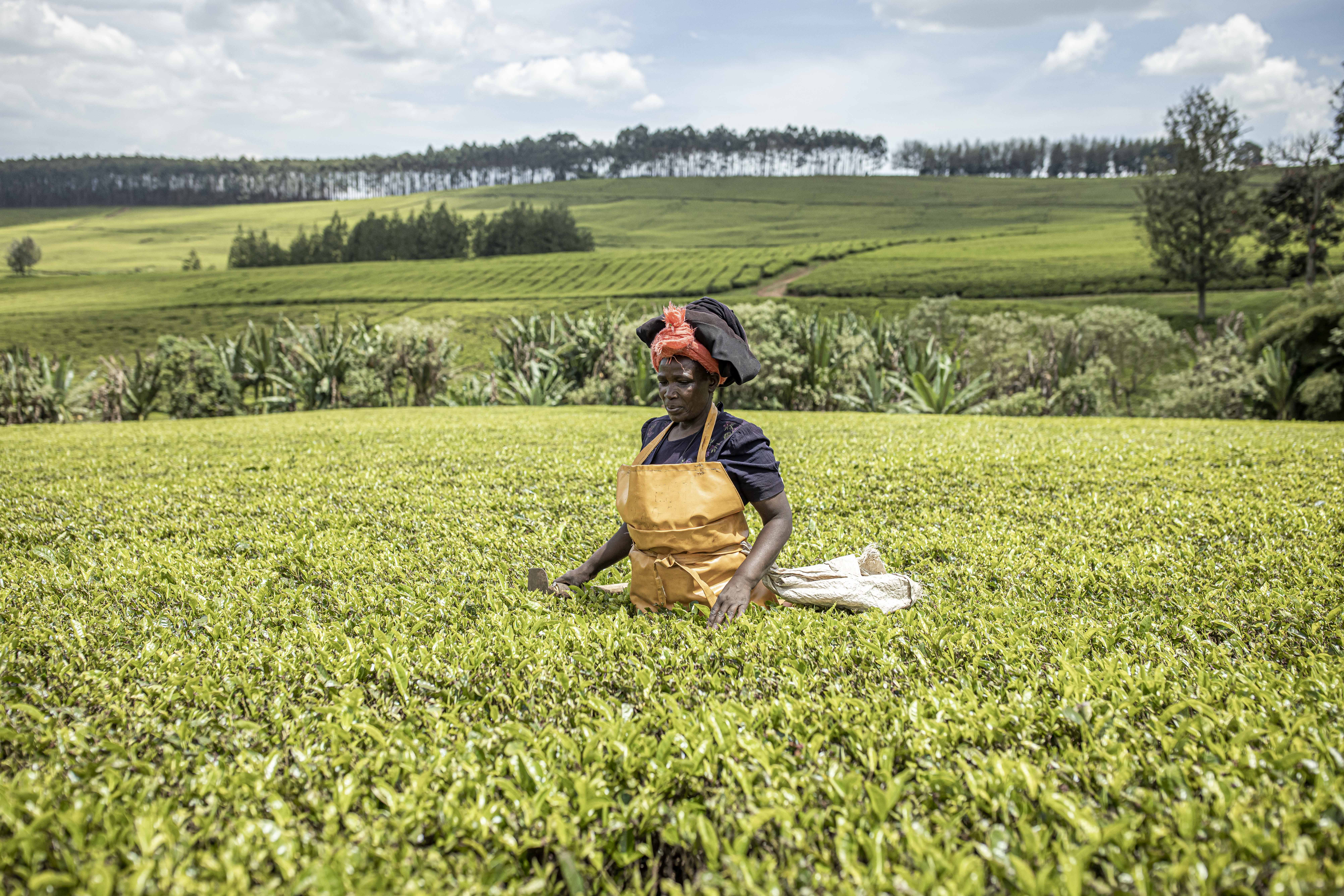Tea is one of Kenya’s main exports and a significant driver of the country’s economy, supporting some 5m direct and indirect jobs across the value chain. According to data from the Tea Board of Kenya (TBK), production volumes rose by 24% from 458.85m kg in 2019 to 570.26m kg in 2023.
This makes Kenya the world’s third largest tea producer after India and China. Meanwhile, export earnings from tea hit a record Sh215.21bn ($1.7bn) in 2024, up from Sh180.5bn ($1.4bn) in 2023. This was partly driven by access to new export destinations, with Kenyan tea shipments reaching 96 countries in 2024, up from 92 in the previous year.
Pakistan is the top export destination for Kenyan tea, importing 206.27m kg in 2024 and accounting for 34.7% of the country’s total tea export volumes. Other major buyers include Egypt (86.90m kg), the UK (57.44m kg), UAE (30.50m kg), Russia (28.46m kg), India (17.13m kg), Saudi Arabia (15.92m kg), Yemen (14.13m kg), Iran (13m kg) and China (12.42m kg). Collectively, these ten countries – most of them long-established markets for Kenyan tea – accounted for 81% of total tea export volume in 2024.
Despite the positive momentum of recent years, a drop in production was recorded in the first quarter of 2025. In January, output decreased to 54.36m kg, down from 58.95m kg a year earlier. February’s production dropped to 44.61m kg, compared to 55.44m kg the previous year, while March figures fell sharply to 37.93m kg from 54.34m kg in the same month of 2024.
TBK attributed this slowdown to poor rainfall and global trade disruptions “Tea performance remains under pressure from weather and global shocks. Kenya produced 51.78m kg of tea in April, 3.85% less than April 2024, mainly due to low rainfall… Disruptions from the Russia-Ukraine war, Red Sea attacks and Sudan conflict affected global buying,” TBK stated in its industry performance report for April.
Supporting smallholders
The Kenyan tea industry is underpinned by two primary production systems: smallholder farmers and large-scale estates. While major multinationals such as Unilever Tea Kenya, James Finlay and Eastern Produce Kenya engage in large-scale tea cultivation and processing – collectively accounting for approximately 40% of the country’s total tea output – it is the smallholder farmers who are the lifeblood of the sector.
Smallholders, who typically cultivate tea on plots measuring less than half an acre, produce 60% of the country’s tea. They are organised into cooperatives under the Kenya Tea Development Agency (KTDA), which manages tea factories and provides essential support services to tea farmers.
KTDA collects green tea leaves from over 600,000 smallholders, processing the leaves at 70 factories spread out across Kenya’s tea-growing regions. Utilising the crush, tear, curl (CTC) method, KTDA’s factories produce black tea that is well-suited for global blends. KTDA markets its tea through the Mombasa Tea Auction, direct sales and factory-door sales. KTDA also engages in policy advocacy, helping draw attention to the opportunities and challenges facing the industry. Chief among the issues that KTDA has been engaged on lately is climate change.
Chege Kirundi, chairman of KTDA, contends that smallholders need increased support to bolster their resilience against climate change, which he argues poses a significant threat to tea production yields.
“We are investing in drought-resistant tea varieties and efficient irrigation systems to help farmers adapt,” he said at a function at Gacharage Tea factory in Murang’a town in May to mark International Tea Day.
Speaking at the same event, Ndung’u Gathenji, TBK chairman, echoed KTDA’s sentiments on the need to strengthen smallholders’ capacity to confront climate change. “Kenya’s tea sector has long been a global leader, renowned for quality, volume and consistency… but as we celebrate our achievements, we must also confront the realities of climate change,” he noted.
According to KTDA’s Climate Risk Mapping study, climate change could reduce tea yields by up to 20% in the coming decades if efforts to boost farmers’ resilience are not amplified.
Beyond climate change, other challenges facing smallholder farmers in Kenya’s tea sector include concerns over low wages for factory and field workers, rising production costs and stagnant global tea prices. All these contribute to constrained incomes for farmers and workers. Indeed, a recent study by the Fairtrade Foundation found that only one in five tea workers and farmers in Kenya are earning enough each month to support their families with essentials.
Boosting local value addition
According to TBK, value-added tea exports amounted to 28.90m kg in 2024, representing just 5% of Kenya’s total tea exports during the year. To change this, Africa’s largest tea producer and exporter is increasingly focused on boosting local value addition, with the government setting an ambitious target to grow the share of value-added exports tenfold to 50% by 2027.
“This strategic move is envisaged to create jobs, increase earnings and develop enterprises along the tea value chain,” says Rachel Wanyoike, the managing director of Solidaridad East and Central Africa.
“All tea, including green, black, white, matcha and pu-erh [a fermented tea], is made from the Camellia sinensis plant. Increasing value in tea involves imbuing the product with added features or integrating more of the production process at origin,” she notes.
“Value addition has the potential to increase smallholder farmers’ incomes by up to 40% when compared with non-value-added conventional tea. Practices can include packaging, branding, blending and obtaining quality certifications. Producing flavoured teas or instant varieties represent other lucrative opportunities,” she adds.
Black tea accounts for approximately 96% to 98% of Kenya’s total output, while specialty teas – such as green, white, oolong and purple – make up a small but growing share.
Wanyoike notes that global demand for specialty tea is rising steadily as more marketers tout their supposed health benefits. “There is an increasing demand for specialty teas like the native Kenyan purple tea, known for its health benefits including less caffeine and high levels of antioxidants.”
The rise in demand for specialty tea has unlocked opportunities for the likes of Flora Mutahi, founder and CEO of Melvin Marsh International, which owns Melvins Tea. Founded in Kenya in 1994, Melvins Tea offers specialty teas such as flavoured black and green teas, fruit and herbal infusions and orthodox teas. They were the first to introduce flavoured tea to the Kenyan market, back in 1995, and currently sell their products in Kenya and globally.
Mutahi tells African Business that the company uses “100% natural, Kenyan-grown ingredients” and processes their tea within the country – thus creating direct and indirect jobs locally.
She credits the company’s ability to successfully carve a niche in the specialty tea category to “innovation and being customer-centric,” citing recent product launches designed to respond to evolving consumer preferences.
“Being very customer-centric has helped us grow. We have now come out with an instant tea that has milk and sugar. Health is another important consumer trend driving the category, and we have introduced health infusion flavours,” she says.
Mutahi contends that improved access to quality packaging material will help grow the volumes of value-added tea exports in Kenya. Many Kenyan tea processors struggle to source high-grade packaging paper that meets international standards for shelf life, branding and food safety. This limits access to premium export markets that would justify the investment in local processing and branding.
“The biggest challenge is sourcing packaging material that can be trusted enough to sit on a shelf in New York,” she explains, adding that, even when packaging material is accessible, market access can still be hindered by low brand awareness in overseas markets.
Mutahi argues that stronger country marketing and export promotion need to be encouraged to ensure that locally produced tea brands command a premium in global markets.
“Promoting a brand in a foreign market is hard, especially when the public and private sector aren’t aligned. We need a unified approach, similar to how the South African government and private sector are pushing country marketing and brand building for their wine industry.”



